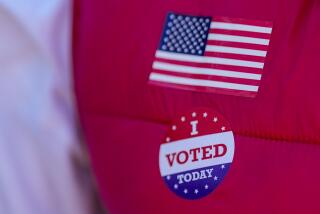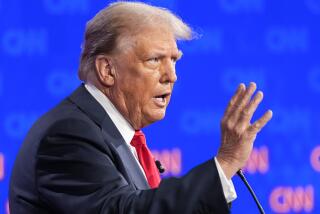The Positive Purpose in Negative Campaigns
WASHINGTON — Among the many sins of the 1988 presidential contest, perhaps the worst is the way the good name of negative campaigning has been besmirched. The hands of our most distinguished commentators have been wrung like mops, the aches in their bellies allowed full voice, all in protest against the tenor of discourse between George Bush and Michael S. Dukakis.
This orchestra of gnashed teeth has been tuned to a fundamental aesthetic judgement that negative campaigning is, of itself, bad. But negativism isn’t the problem. Stupidity is--and by not differentiating between a stupid campaign and a negative one, we’re heading toward a judgment that the moment a candidate goes negative, he’s created a breach in the social order. Negative campaigning’s ubiquitous byproduct, the 30-second negative spot, will soon unfairly take on the leper’s air, or at least the kind of opprobrium reserved for, say, smoking in public.
There are three reasons why negative campaigning is a mighty good thing. To begin with: history. U.S. presidential campaigns since the early 19th Century have often been nasty and negative affairs. Second, there is an intrinsic regulator to negative campaigning: In order to work, and not create a backlash, a negative attack must be truthful, fair and, in many cases, delivered with mitigating humor to add levity to what often seems an interminable campaign. Most important, negative campaigning is effective.
Stupidity, however, is a different matter--and that’s where aesthetic complaints should be leveled. Legitimate comparisons between the candidates’ records and positions are condemned because they’re delivered in a negative tone. What should be condemned is the stupidity with which many of these attacks, verbal and visual, have been delivered.
The metaphors of Campaign ‘88--drowned rubber ducks, rotting fish heads and Jane Fonda’s naval--are dumb, pure and simple, as are rumbles in tanks and trips to flag factories. But many commentators can’t distinguish between legitimate symbolism and the sophomoric level of this kind of dialogue. By not differentiating between negative campaigning and stupidity, many who complain about the former are guilty of the latter.
Legitimate negative campaigning has driven the poll numbers of this race, right up to the debate.
In a May 16 New York Times/CBS poll, Dukakis led Bush by 10 points, 49% to 39%. Worse for the vice president, his negatives were high--35% of those polled viewed him negatively, compared with 33% favorable. Dukakis, on the other hand, having swept through the New York primary splattered by none of its carnage, had a favorable rating of 38%, his negatives a comfortable 14%. At that time, he’d been body-slamming the political pinball machine, ringing up points by going after the Bush-Noreiga connection, the Iran-Contra affair and other negative but, to the electorate, legitimate issues. He was the paradigm of the political tabula rasa: a blank projection screen on which liberals and conservatives alike viewed him in their image. For Bush to have allowed the governor of Massachusetts to have painted in his own portrait would have been fatal.
In June, Bush, and through him, America, became acquainted with Willie Horton, the furloughed Massachusetts prisoner whose rampage on a weekend pass provided the GOP with sufficient paint to daub in Dukakis’ likeness. The result was Dukakis heading to Atlanta with his lead cut and his negatives up. On July 11, the New York Times/CBS poll showed Dukakis’ favorables down from 38% to 28%, and his negatives up from 14% to 21%.
The Bush attack worked and, though not exactly pretty, it was legitimate. Those who imagine that presidential politics ought to have Lincoln debating Douglas each quadrennial were bound to have their love of Dukakis and Bush permanently qualified. But what Bush did was well within the tradition of political hardball; so was Dukakis’ implication that Bush and the ayatollah were pen pals.
After the Democratic Convention, the Duke widened his lead to 17 points, his favorables stretching heavenward: 38% to 19%. Bush’s negatives remained high, and conventional wisdom had it that this was his penance for having “gone negative”--though the suspicion remains that Ann Richards and others who opened the bomb bays to drop a ton of ridicule on Bush had their desired effect.
Bush then let loose on Dukakis for being a tenderfoot on foreign policy, for his flip-flop on strategic issues and his fealty, or lack of, to every red-blooded American’s daily recitation of the Pledge of Allegiance. Here’s where alarums about sins of negative campaigning hit full bay--and the point was missed.
The pledge was a respectable issue for Bush to wedge between Dukakis and the public. At least the public thought so, because by Sept. 13, not only did polls show Bush ahead of Dukakis by 47% to 39%, but Bush’s positives were up to 40% and his negatives down to 28%. If voters thought his tactics illegitimate, his favorable rating would not have risen so high and his negatives would have compounded. No, the pledge issue allowed Bush to make Lazarus look like an amateur.
Dukakis, on the other hand, was stung by the pledge wedge, his negative swimming above his positives by 31% to 28%. Here is where the failure to distinguish between legitimate negativism and sheer stupidity became most obvious. The Bush advisers didn’t just focus on the Pledge of Allegiance, they had Bush start campaigning in a town nicknamed “Flag City,” and later, with a total absence of shame, sent him to a New Jersey flag factory. This latter trip must have looked like the icing on the cake when planned but it left TV viewers feeling like they’d just been forced to eat plain sugar.
Dukakis, who exhibited verbal silliness earlier when he compared President Reagan’s leadership to a rotten fish, now responded to Bush’s taunt by a singularly dumb visual: his ride on an M1A1 tank. Not to be outdone, Sen. Dan Quayle said Dukakis’ naval adviser, a rubber duck, had drowned in a bathtub. When Bush kicked off his campaign in Orange County, Lloyd Bentsen, normally a reserved fellow, said Bush had gone to Disneyland to meet with his economic advisers. And so on.
Otherwise intelligent politicians got in on the act, with Gov. Mario M. Cuomo of New York calling reporters to say, “I picture George (Bush) in a club where they sit in turbans sipping martinis, wearing pointy shoes and where they dream of the pleasure dome.” Not negative, just dumb.
Yet, what ends up getting denounced when such lines escape the playground is negative campaigning. And that’s wrong.
Those who sing paeans to democracy and invoke the Lincoln-Douglas debates miss the point. Were Lincoln alive, he probably would hire a Lee Atwater or John Sasso to run his campaign. (Though it’s doubtful he’d need a Roger Ailes as debate coach.) Those who think campaigns should be exclusively positive believe in a Platonic ideal that doesn’t exist for those who wish to win.
According to historian Paul F. Boller Jr., Andrew Jackson was accused of “adultery, gambling, cock fighting, bigamy, slave trading, drunkenness, theft, lying and murder.” John Quincy Adams was, in turn, said to have had premarital relations with his wife and to have procured young women for Czar Alexander I. In the debate between Bush and Dukakis in last week, neither accused his opponent of cock fighting.
Attacks on Bush’s relations with Gen. Manuel A. Noriega are as legitimate as attacks on Dukakis’ relations to the pledge. It’s the flag factories and tanks from which we deserve deliverance.
More to Read
Get the L.A. Times Politics newsletter
Deeply reported insights into legislation, politics and policy from Sacramento, Washington and beyond. In your inbox three times per week.
You may occasionally receive promotional content from the Los Angeles Times.










